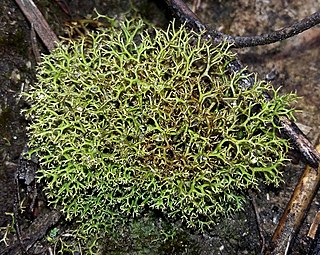
Cladia is a genus of lichenized fungi in the family Cladoniaceae. Cladia species have a crustose primary thallus and a fruticose, secondary thallus, often referred to as pseudopodetium. The type species of the genus, Cladia aggregata, is widely distributed, occurring from South America, South Africa, Australasia and South-East Asia to southern Japan and India. Most of the other species are found in the Southern Hemisphere.

Punctelia is a genus of foliose lichens belonging to the large family Parmeliaceae. The genus, which contains about 50 species, was segregated from genus Parmelia in 1982. Characteristics that define Punctelia include the presence of hook-like to thread-like conidia, simple rhizines, and point-like pseudocyphellae. It is this last feature that is alluded to in the vernacular names speckled shield lichens or speckleback lichens.

Lepraria is a genus of leprose crustose lichens that grows on its substrate like patches of granular, caked up, mealy dust grains. Members of the genus are commonly called dust lichens. The main vegetative body (thallus) is made of patches of soredia. There are no known mechanisms for sexual reproduction, yet members of the genus continue to speciate. Some species can form marginal lobes and appear squamulose. Because of the morphological simplicity of the thallus and the absence of sexual structures, the composition of lichen products are important characters to distinguish between similar species in Lepraria.
Syo Kurokawa was a noted Japanese lichenologist and 1994 recipient of the Acharius Medal. He studied under Mason Hale and Yasuhiko Asahina.

Lecanoric acid is a chemical produced by several species of lichen. Lecanoric acid is classified as a polyphenol and a didepside and it functions as an antioxidant. The acid is named after the lichen Lecanora. The acid has also been isolated from Usnea subvacata, Parmotrema stuppuem, Parmotrema tinctorum,Parmotrema grayana, Xanthoparmelia arida and Xanthoparmelia lecanorica. A related compound, 5-chlorolecanoric acid, is found in some species of Punctelia.
Parmotrema acrotrychum is a species of lichen in the family Parmeliaceae. First discovered in Papua New Guinea, it was originally described in 1979 by Japanese lichenologist Syo Kurokawa as a species of Parmelia. Heinar Streimann transferred it to the genus Parmotrema in 1986. The lichen has also been found in Queensland (Australia) and Malaysia. It has been shown to contain a variety of secondary chemicals, including atranorin, fumarprotocetraric acid, succinprotocetraric acid, chloroatranorin, protocetraric acid, protolichesterinic acid, and lichesterinic acid.
Nipponoparmelia is a genus of five species of lichen belonging to the family Parmeliaceae. Nipponoparmelia was originally conceived by Syo Kurokawa as a subgenus of the genus Parmelia in 1994. It was raised to generic status in 2010. Four east Asian species were originally placed in the genus; Nipponoparmelia perplicata, found in South Korea and Russia, was added in 2014.

Hertelidea is a genus of crustose lichens in the family Stereocaulaceae. Characteristics of the genus include carbon-black ring or outer margin (exciple) around the fruit body disc (apothecium), eight-spored, Micarea-type asci and mostly simple, hyaline ascospores that lack a transparent outer layer. Hertelidea species mostly grow on wood, although less frequently they are found on bark or soil. While the type species, Hertelidea botryosa, has a widespread distribution, most of the other species are found only in Australia.
Amandinea devilliersiana is a species of crustose lichen in the family Caliciaceae, and found in South Australia. It was first described in 2013 by Australian lichenologists Jack Elix and Gintaras Kantvilas from a specimen collected on a granite boulder near the seashore in South Australia. The species epithet, devilliersiana, honours Brigitte de Villiers. Specimens used for the description came from both Tasmania and South Australia.
Punctelia transtasmanica is a species of foliose lichen in the family Parmeliaceae. It is found in Australasia.
Punctelia negata is a little-known species of foliose lichen in the family Parmeliaceae. It is found in South America.
Punctelia subalbicans is a species of foliose lichen in the family Parmeliaceae. It is found in Australia and New Zealand, where it grows on the bark of various tree species.
Hertelidea wankaensis is a species of crustose lichen in the family Stereocaulaceae. It is found in northeastern Australia, where it grows on dead wood.
Punctelia pseudocoralloidea is a species of foliose lichen in the family Parmeliaceae. It is found in Australia, where it grows on bark and on wood.
Punctelia subflava is a species of foliose lichen in the family Parmeliaceae that occurs in Australia.

Punctelia borreri is a species of foliose lichen in the family Parmeliaceae. It is a common and widely distributed species, occurring in tropical, subtropical, and temperate regions of Africa, Asia, Europe, North America, Oceania, and South America. The lichen typically grows on bark of deciduous trees, and less commonly on rock. Some European countries have reported increases in the geographic range or regional frequency of the lichen in recent decades, attributed alternatively to a reduction of atmospheric sulphur dioxide levels or an increase in temperatures resulting from climate change.

Salazinic acid is a depsidone with a lactone ring. It is found in some lichens, and is especially prevalent in Parmotrema and Bulbothrix, where its presence or absence is often used to help classify species in those genera.
Xanthoparmelia annexa is a foliose lichen species in the family Parmeliaceae. It was first formally described as a new species in 1964 by Japan lichenologist Syo Kurokawa. After being transferred to genus Paraparmelia in 1986, John Elix transferred it to the genus Xanthoparmelia in 2003 after the two genera were deemed to be synonymous.

Constictic acid is a chemical compound of the depsidone class. It was first isolated in 1968 from lichen of the genus Usnea. It has since been found in many other lichen genera including Menegazzia, Crespoa, and Xanthoparmelia.







